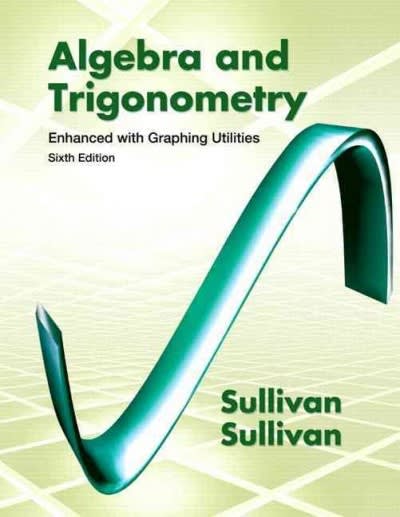Question
4. Use the probability distribution for the random variable x to answer the question. x 0 1 2 3 4 5 p ( x )
4.
Use the probability distribution for the random variablexto answer the question.
| x | 0 | 1 | 2 | 3 | 4 | 5 |
|---|---|---|---|---|---|---|
p(x) | 0.05 | 0.25 | 0.2 | 0.05 | 0.15 | 0.3 |
Find, 2, and. (Round your standard deviation to two decimal places.)
= ?
2= ?
= ?
5.
Use the probability distribution for the random variablexto answer the question.
| x | 0 | 1 | 2 | 3 | 4 | 5 |
|---|---|---|---|---|---|---|
p(x) | 0.35 | 0.17 | 0.2 | 0.19 | 0.06 | 0.03 |
Locate the interval 2 on thex-axis of a probability histogram. You are given that themean is1.53and thestandard deviation is1.43.What is the probability thatxwill fall into this interval?
7.
Use the probability distribution for the random variablexto answer the question.
| x | 0 | 1 | 2 | 3 | 4 |
| p(x) | 0.12 | 0.3 | 0.3 | 0.16 | 0.12 |
Calculate the population mean, variance, and standard deviation. (Round your standard deviation to three decimal places.)
mean = ?
variance = ?
standard deviation = ?
8.
Use the probability distribution for the random variablexto answer the question.
| x | 0 | 1 | 2 | 3 | 4 |
| p(x) | 0.12 | 0.35 | 0.35 | 0.06 | 0.12 |
What is the probability thatxis greater than2?
11.
The maximum patent life for a new drug is 17 years. Subtracting the length of time required by the FDA for testing and approval of the drug provides the actual patent life of the drugthat is, the length of time that a company has to recover research and development costs and make a profit. Suppose the distribution of the lengths of patent life for new drugs is as shown here.
| Years,x | 3 | 4 | 5 | 6 | 7 | 8 | 9 | 10 | 11 | 12 | 13 |
|---|---|---|---|---|---|---|---|---|---|---|---|
| p(x) | 0.02 | 0.07 | 0.07 | 0.12 | 0.18 | 0.19 | 0.16 | 0.10 | 0.05 | 0.03 | 0.01 |
(a)
Find the expected number of years of patent life for a new drug.
(b)
Find the standard deviation ofx. (Round your answer to four decimal places.)
(c)
Find the probability thatxfalls into the interval2.
12.
Most coffee drinkers take a little time each day for their favorite beverage, and many take more than one coffee break every day. The table below, adapted from a certain newspaper, shows the probability distribution forx, the number of coffee breaks taken per day by coffee drinkers.
| x | 0 | 1 | 2 | 3 | 4 | 5 |
| p(x) | 0.13 | 0.16 | 0.37 | 0.27 | 0.06 | 0.01 |
(a)
What is the probability that a randomly selected coffee drinker would take no coffee breaks during the day?
(b)
What is the probability that a randomly selected coffee drinker would take more thantwocoffee breaks during the day?
(c)
Calculate the mean and standard deviation for the random variablex. (Round your standard deviation to three decimal places.)
mean ............? coffee breaks
standard deviation ......? coffee breaks
(d)
Find the probability thatxfalls into the interval
2.
13.
Evaluate the probability when n=9 and p=0.3. (Round your answer to three decimal places.)
P(x1)
.......???
You may need to use the appropriateappendix tableto answer this question.
23.
In a certain population,83% of the people have Rh-positive blood. Suppose that two people from this population marry. What is the probability that they are both Rh-negative, thus making it inevitable that their children will be Rh-negative?
Step by Step Solution
There are 3 Steps involved in it
Step: 1

Get Instant Access to Expert-Tailored Solutions
See step-by-step solutions with expert insights and AI powered tools for academic success
Step: 2

Step: 3

Ace Your Homework with AI
Get the answers you need in no time with our AI-driven, step-by-step assistance
Get Started


